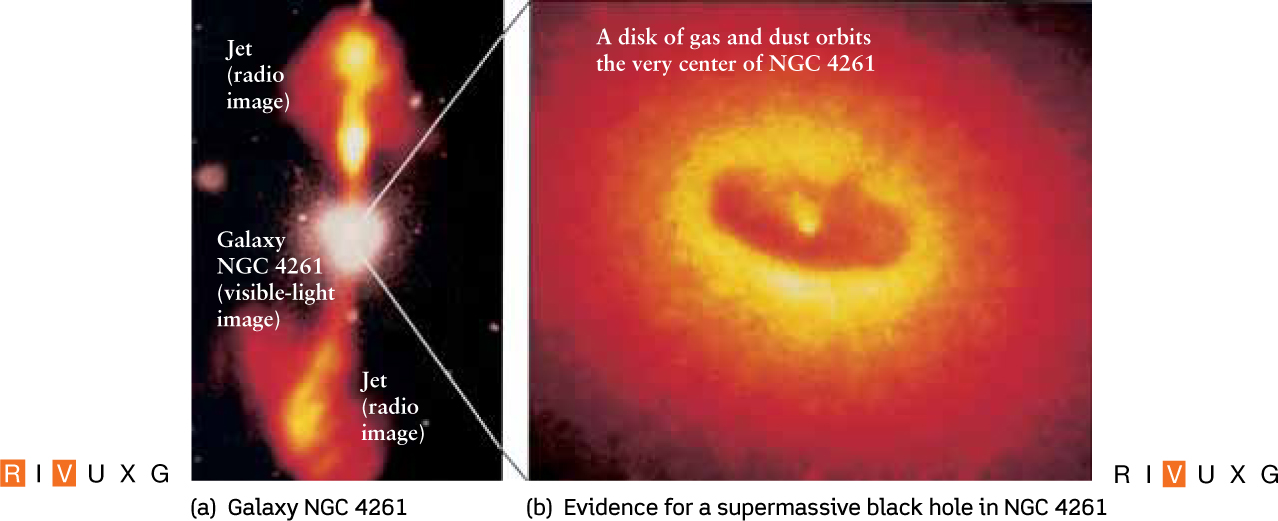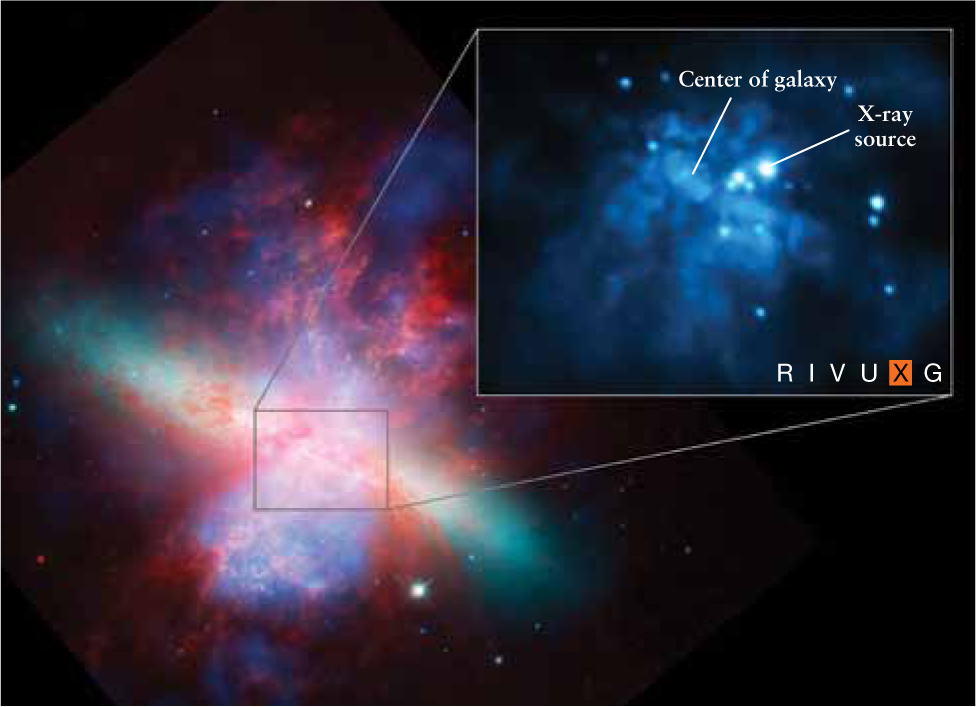21-5 Supermassive black holes exist at the centers of most galaxies
Stellar evolution makes it possible to form black holes with masses several times that of the Sun. But calculations suggest other ways to form black holes that are either extremely large or extraordinarily small.
Supermassive Black Holes
The largest black holes have billions of times the mass of the Sun
As we will discuss in Chapter 25, galaxies formed in the early universe by the coalescence of gas clouds. During this formation process, some of a galaxy’s gas might plunge straight toward the center of the galaxy, where it collects and compresses together under its own gravity. If this central clump has enough mass, it can form a black hole. Typical galaxies have masses of 1011 M⊙, so even a tiny percentage of the galaxy’s gas collected at its center would give rise to a supermassive black hole with a truly stupendous mass.
CAUTION!
While stellar-mass–size black holes require incomprehensibly high-density material to form, supermassive black holes require much lower-density material to form. For example, if you imagine filling our solar system with water out to the orbital distance of Earth, the total mass of water in this sphere would be around 500 million M⊙, and a supermassive black hole would form! In other words, a supermassive black hole can be formed with an average density equal to that of water. Because larger black holes require lower average densities to form compared to smaller black holes, supermassive black holes might form through less extreme processes than stellar-mass–size black holes.
Since the 1970s, astronomers have found evidence suggesting the existence of supermassive black holes in other galaxies. With the advent of a new generation of optical telescopes in the 1990s, it became possible to see the environments of these suspected black holes with unprecedented detail (Figure 21-15). Figure 21-15a shows radio emissions from two jets that extend some 15,000 pc (50,000 ly) from the center of the galaxy NGC 4261. These resemble an immensely magnified version of the jets seen emerging from some stellar-mass black holes (see Section 21-3). The highly magnified Hubble Space Telescope image in Figure 21-15b shows a disk some 250 pc (800 ly) in diameter at the very center of this galaxy. The jets are perpendicular to the plane of the disk, just as in Figure 21-11.

 A Supermassive Black Hole The galaxy NGC 4261 lies some 30 million pc (100 million ly) from Earth in the constellation Virgo. (a) This composite view superimposes a visible-light image of the galaxy (white) with a radio image of the galaxy’s immense jets (orange). (b) This Hubble Space Telescope image shows a disk of gas and dust about 250 pc (800 ly) across at the center of NGC 4261. Observations indicate that a supermassive black hole is at the center of the disk.
A Supermassive Black Hole The galaxy NGC 4261 lies some 30 million pc (100 million ly) from Earth in the constellation Virgo. (a) This composite view superimposes a visible-light image of the galaxy (white) with a radio image of the galaxy’s immense jets (orange). (b) This Hubble Space Telescope image shows a disk of gas and dust about 250 pc (800 ly) across at the center of NGC 4261. Observations indicate that a supermassive black hole is at the center of the disk.
619
By measuring the Doppler shifts of light coming from the two sides of the disk, astronomers found that the disk material was orbiting around the bright object at the center of the disk at speeds of hundreds of kilometers per second. (By comparison, Earth orbits the Sun at 30 km/s.) Given the size of the material’s orbit, and using Newton’s form of Kepler’s third law (see Section 4-7 and Box 4-4), they were able to calculate the mass of the central bright object. The answer is an amazing 1.2 billion (1.2 × 109) solar masses! What is more, the observations show that this object can be no larger than our solar system. The only known explanation is that the object at the center of NGC 4261 is a black hole.
Dozens of other black holes in the centers of galaxies have been identified by their gravitational effect on surrounding gas and dust. Surveys of galaxies have shown that supermassive black holes are not at all unusual; most large galaxies appear to have them at their centers. As we will see in the next chapter, a black hole with several million solar masses lies at the center of our own Milky Way Galaxy, some 8000 pc (26,000 ly) from Earth.
Other Black Holes
Theoretically, a black hole can have any mass, but the masses of black holes that exist reflect what can be produced through natural processes. The black hole masses we do observe seem to fall into two very different groups. Supermassive black holes have masses from 106 to 109 M⊙, while stellar-mass black holes like those discussed in Section 21-3 have masses around 10 M⊙. In 2000 a team of astronomers from Japan, the United States, and Great Britain reported finding a “missing link” between these two groups.
The new discovery was a fluctuating X-ray source located some 200 pc (600 ly) from the center of the galaxy M82 (Figure 21-16). Images do not reveal material orbiting around this source, so we cannot determine the source’s mass using Newton’s form of Kepler’s third law (see Box 4-4). But by relating the source’s X-ray luminosity to the rate at which matter would have to fall onto the source to produce that luminosity, it can be shown that the source must have a mass of at least 500 M⊙ or so. The rapid fluctuations of the source show that it has a very small diameter, which suggests that it is a black hole (see Section 21-3). Hence, the source in M82 may be an intermediate-mass black hole (also called a mid-mass black hole) Additional intermediate-mass black hole candidates have been found in other galaxies. Such black holes might have formed by the coalescence of many normal stars or by the direct merger of stellar-mass black holes.

 R I V U X G
R I V U X GAn Intermediate-mass Black Hole? The largest black holes have billions of times the mass of the Sun. M82 is an unusual galaxy in the constellation Ursa Major. The inset is an image of the central region of this galaxy from the Chandra X-ray Observatory. The bright, compact X-ray source varies in its light output over a period of months. The properties of this source suggest that it may be a black hole of roughly 500 solar masses or more. If correct, the intermediate-mass black hole is about 600 ly away from a supermassive black hole at the center of the galaxy that has about 30 million solar masses.
During the early 1970s, Stephen Hawking of Cambridge University proposed the existence of yet another type of black hole. He suggested that during the Big Bang some 13.7 billion years ago, local pockets of the universe could have been dense enough and under sufficient pressure to form small black holes. According to his theory, these primordial black holes could have had masses as large as Earth or as small as 5 × 10−8 kg, about 1/40 the mass of a single raindrop. To date, however, no evidence has been found for the existence of primordial black holes in nature.
CONCEPT CHECK 21-9
Do all black holes require extreme densities of matter to form?
CONCEPT CHECK 21-10
Can black holes only exist within certain mass ranges?
620